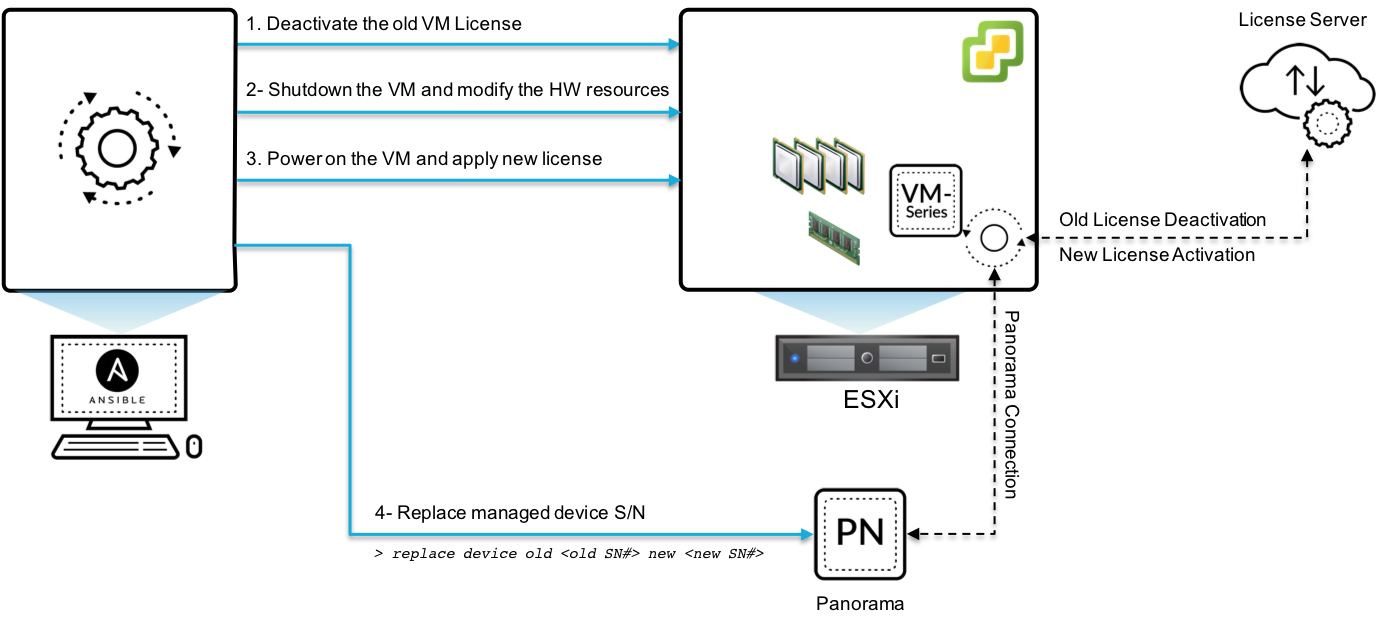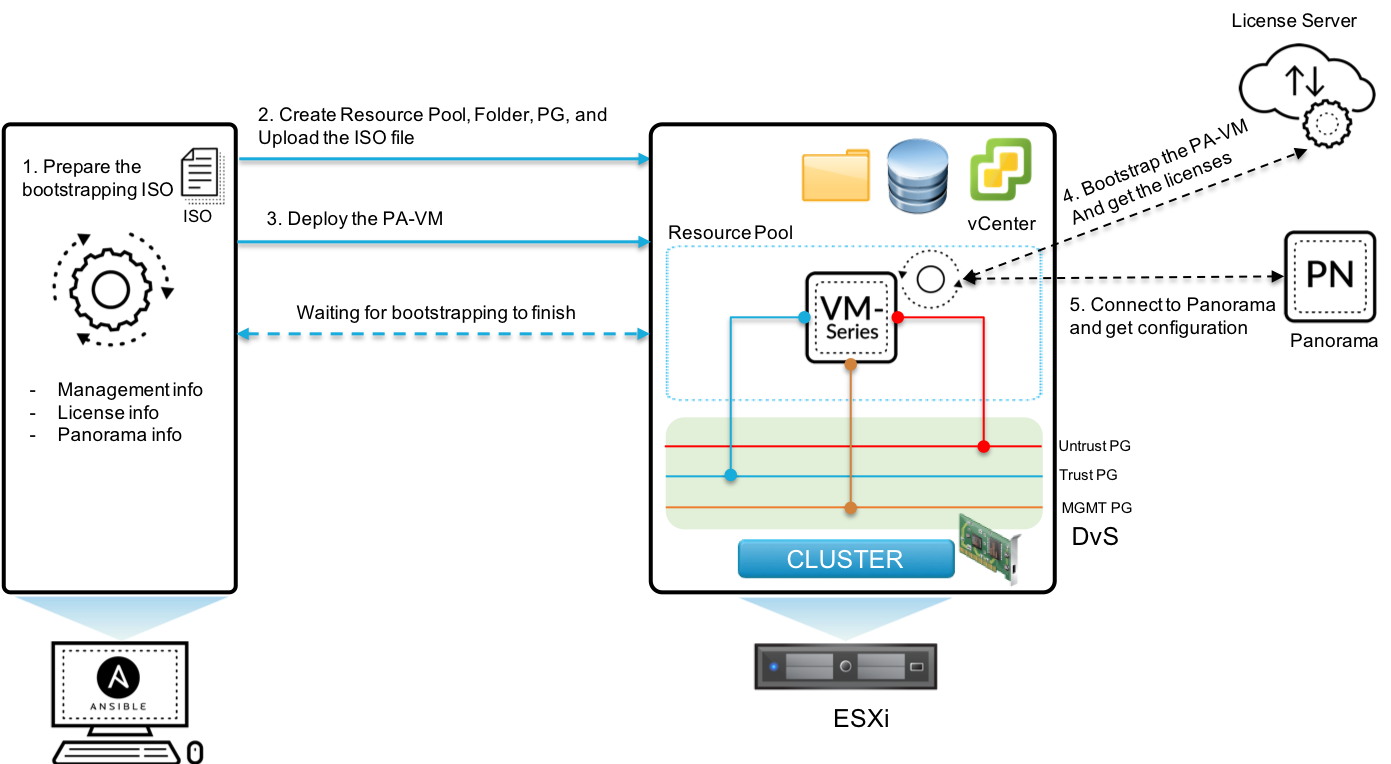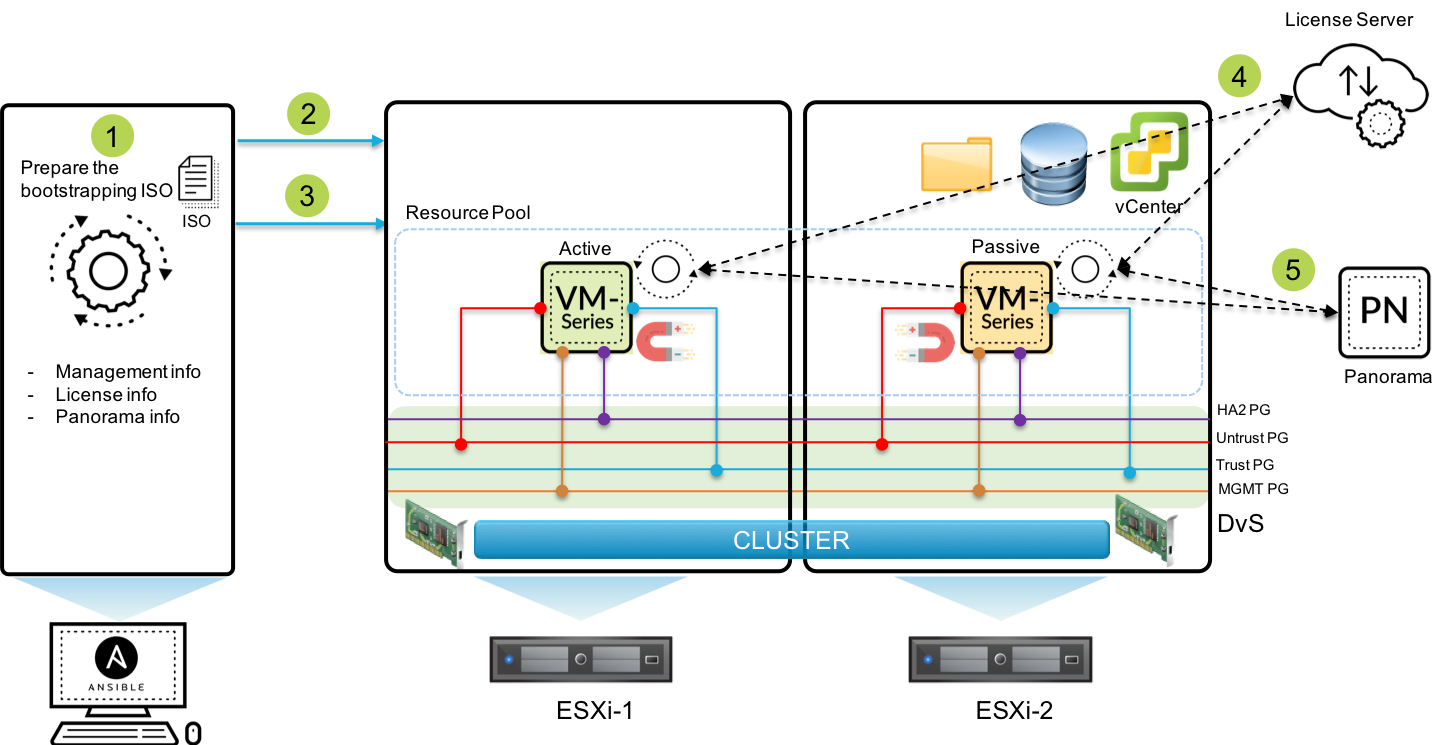Example Ansible playbooks to automate the deployment and scaling up/down of Palo Alto Networks VM-Series
The following use cases can be accomplished via this ansible playbooks.
deploy.yml playbook does the following tasks:
1. Prepare the bootstrapping iso file required to bootstrap PAN-OS and Upload the image to the datastore. More information about bootstrapping can found at PAN-OS [Admin Guide](https://docs.paloaltonetworks.com/vm-series/8-1/vm-series-deployment/bootstrap-the-vm-series-firewall.html#).
2. Prepare the environment at the vSphere by creating Folder, Resource Pool, and port groups.
3. Deploy the PA-VM from datastore template. And attach the bootstrapping ISO.
4. The PA-VM will automatically start the bootstrapping process and retrieve the licenses from Palo Alto Networks License Server.
5. After retrieving the license, the PA-VM will contact Panorama for the configuration (i.e., Network and security policies).
2- Scale UP or Scale Down the PA-VM
Using scaleUp.yml and scaleUp.yml you can scale up or scale down the PA-VM model. For example, you can scale up from VM-50 to VM-100 or from VM-100 to VM-50

scaleUp.yml and scaleUp.yml playbooks do the following tasks:
1. Deactivate the old model license.
2. Shutdown the PA-VM and modify the HW resources to match the new VM model. Check Palo Alto Networks Guide for the HW requirement per model [Admin Guide](https://docs.paloaltonetworks.com/vm-series/8-1/vm-series-deployment/about-the-vm-series-firewall/vm-series-models/vm-series-system-requirements.html#)
3. Power on the PA-VM and retrieve the new license.
4. Finally, update panorama with the new Serial Number.
This use case can be done differently. For example, you can overprovision the PA-VM HW resources and then use Upgrade the VM-Series Model process
3- Remove the deployment. Using remove.yml you can remove the deployment. The playbooks will do the following tasks:
1. Deactivate the PA-VM licenses.
2. Remove the resources from vCenter (VM, Resource pool, Folder, bootstrapping ISO and Portgroups).
4- Deploy and remove PA-VM Active/Passive HA Cluster. Using deployHA.yml and removeHA.yml you can deploy active/passive HA cluster. The playbook will also make sure every PA-VM run in separate host by applying VM/Host affinity rule.
deployHA.yml does the following tasks:
1. Prepare the bootstrapping iso file required to bootstrap PAN-OS and Upload the image to the datastore. More information about bootstrapping can found at PAN-OS [Admin Guide](https://docs.paloaltonetworks.com/vm-series/8-1/vm-series-deployment/bootstrap-the-vm-series-firewall.html#).
2. Prepare the environment at the vSphere by creating Folder, Resource Pool, and port groups.
3. Deploy the Active and Passive PA-VM from datastore template. And attach the bootstrapping ISO. Also, VM/Host affinity rule in order make sure every VM on the cluster is deployed on a separate ESXi Host.
4. The PA-VM will automatically start the bootstrapping process and retrieve the licenses from Palo Alto Networks License Server.
5. After retrieving the license, the PA-VM will contact Panorama for the configuration (i.e., HA configuration, Network, and security policies).
Using removeHA.yml does the following tasks:
1. Deactivate the PA-VM licenses.
2. Remove the resources from vCenter (VMs, Resource pool, Folder, bootstrapping ISOs and Portgroups).
-
Prerequisites. To use this playbook you will need the following packages installed on the Ansible Control Machine (Tested on Ansible 2.7 for MacOS and Ubuntu):
-
Python 2.7
-
pan-python
pip install pan-python
- pyvmomi
pip install pyvmomi
- For Linux you will need mkisofs
apt-get install mkisofs
-
-
Create PA-VM Base image template on vCenter.
-
Download PAN-OS Base image OVA for ESXi from Palo Alto Networks Support Portal
-
Import the OVA to you vCenter Cluster. (Do not power on the VM)
-
Right-click the VM and select Template > Convert to Template
-
-
Download the files:
git clone https://github.com/mohanadelamin/pa-vm-ansible.git
-
Change the variable file variables.yml to meet your requirements.
cd pa-vm-ansible/ vim variables.yml -
Run the playbook. (For example)
ansible-playbook deploy.yml
- The file name Panorama-config.xml contain example Panorama configuration that is required for all the use cases Panorama Configuration
These playbooks is supplied "AS IS" without any warranties and support.

